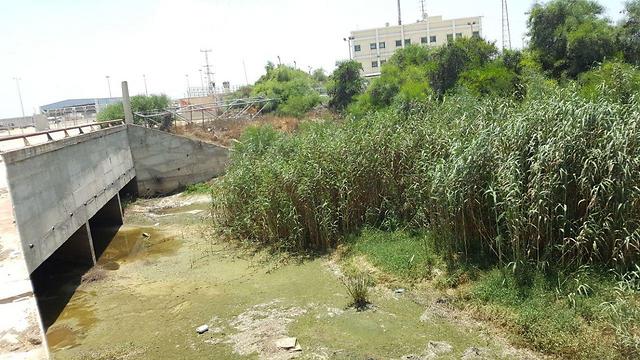

Gaza perimeter agriculture in peril due to water reservoir contamination
With Gaza's sewage treatment facility still nonoperational and Israel having to bear the load of its wastewater, Israeli wastewater reservoirs in strip's perimeter are paying a toll, as their water becomes so contaminated it can no longer be used for irrigation—hurting the region's farmers.
The Ministry of Health instructed farmers in Israeli communities on the Gaza perimeter on Tuesday not to use water from Sderot and Sha'ar HaNegev wastewater reservoirs to irrigate their fields, after it found the water was contaminated by sewage from the Gaza Strip.
Last July, the Sderot Municipality and Sha'ar HaNegev Regional Council, which is situated on the Gaza perimeter, were instructed by the Water Authority to build a new sewage pipe in the vicinity of the Erez Crossing to receive wastewater from Beit Lahiya and Beit Hanun in the Gaza Strip, after the sewage treatment facility there was shut down due to the electricity crisis.
The absorbed sewage was transferred to sewage storage facilities in Kibbutz Erez and then to Sha'ar HaNegev and Sderot's sewage treatment facilities.
Prior to that, sewage from the strip flowed through Nahal Hanun, was stored in the sands of Moshav Netiv HaAsara and contaminated the area and groundwater. Once every few days, Israeli trucks came and pumped the sewage.
The Water Authority said they were "treating the matter as an emergency event, to stop the massive flow of sewage from the Gaza Strip into the territory of the State of Israel (via Nahal Hanun).
"The Water Authority is working to reduce expected damage from Palestinian wastewater overflows and to protect the wells of the area. The flow of sewage from the Gaza Strip toward the State of Israel began long before and without any connection to the electricity problems in Gaza, and we expect the cooperation of all regional bodies in the region."
Recently, the Ministry of Health conducted a series of tests at the site, after which it became clear that the quality of water in the reservoir became too poor to use due to sewage from the Strip.
No good deed goes unpunished
The wastewater treatment plant receives approximately 2,000 cubic meters of sewage from the Gaza Strip every day.
In recent years, the Ministry of Health and the Sha'ar HaNegev Regional Council have demanded a plan to upgrade the facility, but this has not been implemented for various reasons, mainly budgetary.
Farmers on the Gaza perimeter are concerned about the new situation, as in a few weeks they are set to begin pumping water for irrigation of fields and orchards—something that has not been done all winter.
Alon Shuster, head of the Sha'ar HaNegev Regional Council, said that "the good deed we are doing by collecting Gaza's sewage so that it will not contaminate Israel's groundwater brought a heavy punishment on us.
"We are making an effort to cleanse the wastewater and hope that the Ministry of Health will give us time to resolve the issue."
In July, the amount of sewage discharged into Nahal Hanun increased significantly. It was flooded and almost overflowing with contaminated water, which made pumping sewage out of it no longer effective.
The IDF was then forced to block the stream from the Gaza side with mounds of dirt in an attempt to stop the flow of sewage, but the Palestinians broke through the mounds and returned to dumping sewage into the stream.

















